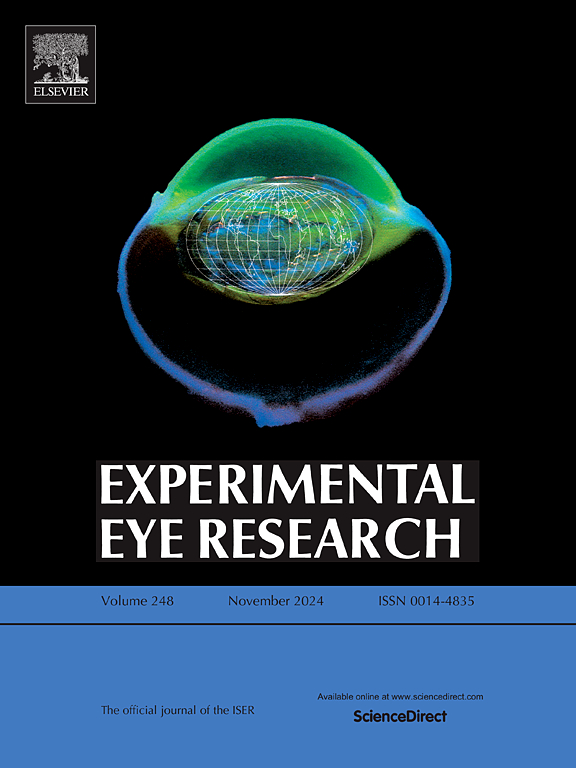TGFβ2 alters segmental outflow and ECM ultrastructure in the trabecular meshwork
IF 3
2区 医学
Q1 OPHTHALMOLOGY
引用次数: 0
Abstract
TGFβ2 is a well-known contributor to extracellular matrix (ECM) changes in the trabecular meshwork (TM). TGFβ2 is increased in the aqueous humor (AH) of primary open angle glaucoma patients and the addition of TGFβ2 to primary human TM cells in culture induces pathogenic changes similar to what is seen in the TM of ocular hypertensive and glaucomatous eyes. Overexpression of a bioactivated form of TGFβ2 using adenovirus 5 (Ad5.TGFβ2) in the TM has previously been described as an inducible mouse model of ocular hypertension and has been utilized for multiple studies to help understand the pathogenies of TGFβ2-induced TM damage and elevated intraocular pressure (IOP). Ad5.TGFβ2 is known to elevate IOP, decrease outflow facility, and increase expression of ECM proteins in the TM. Here, we further analyze the effects of overexpression of TGFβ2 by Ad5 in the TM. We found Ad5.TGFβ2 increases expression of macrophage marker Iba1 and increases expression of ECM proteins fibronectin and collagen 1 compared to Ad5.Null injected controls. In addition, overexpression of TGFβ2 by Ad5 led to a decrease in segmental AH flow regions compared to Ad5.Null control eyes. Ultrastructure analysis of the Ad5.TGFβ2 injected eyes also show significantly more areas occupied by ECM material as well as the development of more smaller giant vacuoles compared to Ad5.Null injected eyes. These data in combination with prior research using Ad5.TGFβ2, establish the use of intraocular injection of Ad5.TGFβ2 as an appropriate mouse model of ocular hypertension to study aqueous humor outflow and its mechanisms.
tgf - β2改变小梁网的节段流出和ECM超微结构
tgf - β2是小梁网(TM)细胞外基质(ECM)变化的一个众所周知的贡献者。tgf - β2在原发性开角型青光眼患者房水(AH)中升高,tgf - β2在培养的原代人TM细胞中添加可引起与眼压和青光眼TM相似的致病性变化。利用腺病毒5 (Ad5.TGFβ2)在TM中过度表达一种生物活化形式的TGFβ2,此前已被描述为一种可诱导的小鼠高眼压模型,并已用于多项研究,以帮助了解TGFβ2诱导的TM损伤和眼压升高(IOP)的发病机制。Ad5。已知tgf - β2可提高眼压,降低流出设施,并增加TM中ECM蛋白的表达。在这里,我们进一步分析了Ad5在TM中过表达tgf - β2的影响。我们找到了Ad5。与Ad5相比,tgf - β2增加巨噬细胞标志物Iba1的表达,增加ECM蛋白、纤维连接蛋白和胶原蛋白1的表达。空注入控件。此外,与Ad5相比,Ad5过表达tgf - β2导致AH流区域的减少。空控制眼。Ad5的超微结构分析。与Ad5相比,注射tgf - β2的眼睛也显示出更多的ECM物质占据的区域,以及更多更小的大液泡的形成。空注射的眼睛。这些数据与先前使用Ad5的研究相结合。tgf - β2,建立眼内注射Ad5的应用。tgf - β2作为小鼠高眼压模型研究房水流出及其机制。
本文章由计算机程序翻译,如有差异,请以英文原文为准。
求助全文
约1分钟内获得全文
求助全文
来源期刊

Experimental eye research
医学-眼科学
CiteScore
6.80
自引率
5.90%
发文量
323
审稿时长
66 days
期刊介绍:
The primary goal of Experimental Eye Research is to publish original research papers on all aspects of experimental biology of the eye and ocular tissues that seek to define the mechanisms of normal function and/or disease. Studies of ocular tissues that encompass the disciplines of cell biology, developmental biology, genetics, molecular biology, physiology, biochemistry, biophysics, immunology or microbiology are most welcomed. Manuscripts that are purely clinical or in a surgical area of ophthalmology are not appropriate for submission to Experimental Eye Research and if received will be returned without review.
 求助内容:
求助内容: 应助结果提醒方式:
应助结果提醒方式:


